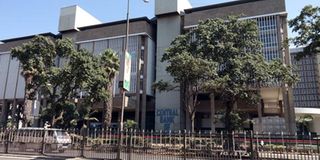Interest rate cap repeal can free credit market

The Central Bank of Kenya building in Nairobi. Recently, the National Treasury’s 2018 Finance Bill has called for a repeal of the ‘rate caps’. PHOTO | FILE | SALATON NJAU
What you need to know:
- Stakeholders have conducted studies to establish the import of the legislation.
- If this arbitrary price control was good for our economy, we would have seen an uptick by January 2017.
- In South Africa, the maximum limit is about 35.4 per cent while the prevailing commercial prime lending rate is 10.5 per cent.
Over the past two years, the introduction of price controls on bank loans and deposits has dominated discourse with a groundswell of public interest on the matter. Recently, the National Treasury’s 2018 Finance Bill has called for a repeal of the ‘rate caps’.
The Banking (Amendment) Act 2016 was motivated by the need to increase credit uptake, particularly for micro and small enterprises and households.
It also sought to promote a savings culture through interest rate regulation — a radical shift from the conventional principles of market-driven dynamics.
Stakeholders — including Kenya Bankers Association (the most fervent defender of market liberalisation), Central Bank of Kenya, World Bank and International Monetary Fund — have conducted studies to establish the import of the legislation.
Market analysts such as the Institute of Economic Affairs and Cytonn Investments also raised a ‘red card’.
TIGHT CONDITIONS
All the surveys revealed that the law is not achieving the intended objective but instead precipitated tight conditions of lending, occasioning a two per cent credit expansion in the private sector — down from 20 per cent in 2015. Moreover, in the space of a year, we have seen 1.2 million fewer loans. The average loan size also increased by 47 per cent — a shift towards big business and middle- and upper-class borrowers.
The law effectively benefits the rich, not ‘Wanjiku’. This shouldn’t be the case, especially because the banking industry (the most regulated of all industries in Kenya) is supervised by CBK, which has at its disposal various policy tools, including the Prudential Guidelines, to moderate industry practices.
Cytonn observed that while the caps may solve the issue of bank spreads, it would lock out SMEs and other “high-risk” borrowers and that the law was based on “an unreasonable premise that the highest extra risk premium in the Kenyan market is four per cent”.
DOWNWARD CURVE
Advocates of the cap argued the pace of borrowing was already on a downward curve. But the Act introduced a distortion from which credit markets have not recovered.
Typically, the market should rebound within three months after a shock. In this case, however, the rate caps have prolonged, if not exacerbated, the situation. If this arbitrary price control was good for our economy, we would have seen an uptick by January 2017.
Indeed, there are markets with controls on loan prices. However, very few of them, if any, have the same extreme approach as ours.
In South Africa, the maximum limit is about 35.4 per cent while the prevailing commercial prime lending rate is 10.5 per cent.
MARKET DYNAMICS
Liberating interest rates to natural market dynamics will open up bank finance, enabling borrowers to access capital while banks get the opportunity to innovate and grow.
For this reason, national Treasury Cabinet Secretary Henry Rotich’s move to repeal the Act is welcome.
It will pave the way for the Treasury and CBK to work with sector stakeholders to chart the best way forward that serves the interest of the economy while promoting financial inclusion and consumer protection.
Dr Olaka is the chief executive officer, Kenya Bankers Association (KBA). [email protected]





